Are you looking for a new 5500 watt generator but you are not sure how to pick one? I have great news for you! Our team here at Generatorist has helped over 600,000 visitors find information about generators and we will help you as well.
If you want to know what appliances is a 5500 watt generator capable of running, check out our popular guide here: What Will a 5500 Watt Generator Run? Otherwise, feel free to begin.
Quick Summary
| Most powerful option | Budget Friendly option | Most Exclusive option |
|---|---|---|
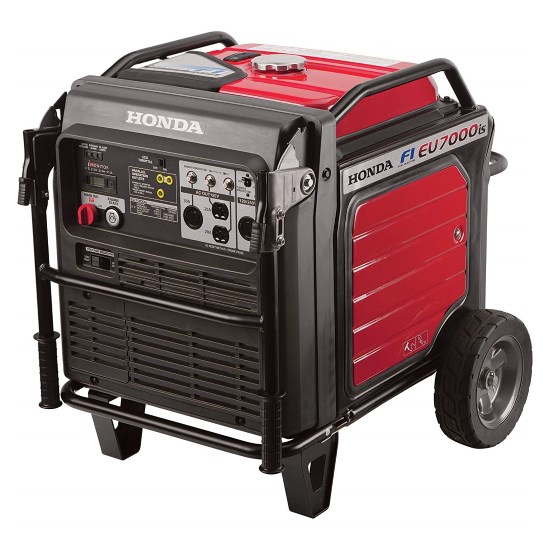
|
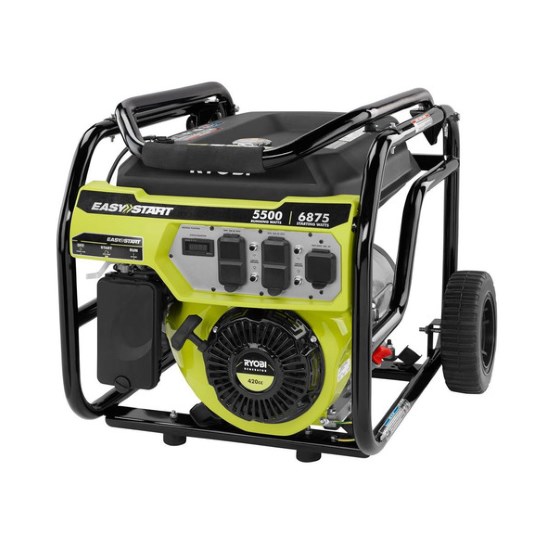
|
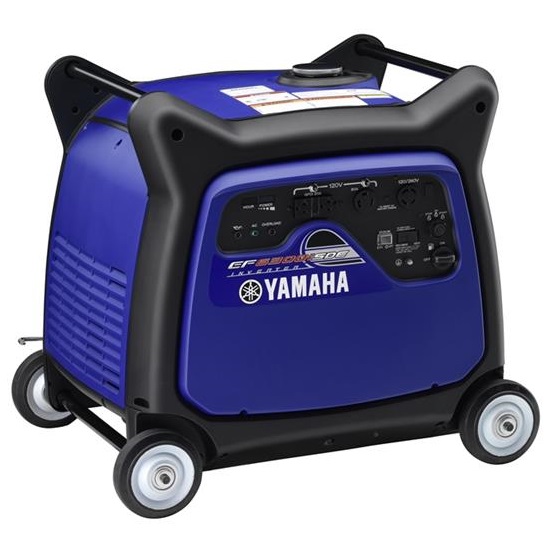
|
| HONDA EU7000iS | Ryobi RY905500 | YAMAHA EF6300iSDE |
| 5500 Running Watts | 5500 Running Watts | 5500 Running Watts |
| 7000 Starting Watts | 6875 Starting Watts | 6300 Starting Watts |
| Runs on Gasoline | Runs on Gasoline | Runs on Gasoline |
| Electric start (recoil backup) | Recoil pull start | Electric start (optional remote) |
| 120/240 AC Voltage | 120/240 AC Voltage | 120/240 AC Voltage |
| No DC Voltage | No DC Voltage | No DC Voltage |
| Runs 18 hours at 25% load | Runs 9 hours at 50% load | Runs 13.3 hours at 25% load |
| 52 dBA at 25% load | 78 dBA at 25% load | 58 - 64 dBA at 25% load |
| 261.5 lb (118.6 kg) weight | 192 lb (87 kg) weight | 200 lb (90.71 kg) weight |
| Check price | Check price | Check price |
How we chose the best
Our Generatorist team went over 700 different portable generators to identify almost 30 machines that we have analyzed down to the smallest details. Out of those, we have selected the following options we consider to be the best.
the Most powerful option
| PREFERRED FEATURES | |||
|---|---|---|---|
| Electric Start: | Yes (No Remote) | Dual Fuel: | No |
| Recoil Backup Start: | Yes | Fuel Gauge: | Yes (Dial) |
| Inverter: | Yes | Metal Fuel Tank: | Yes |
| Idle Control: | Yes (Eco Throttle) | Electric Fuel Injection: | Yes |
| Battery Included: | Yes | Fuel Shutoff Valve: | No |
| Low Oil Shutoff: | Yes | Spark Arrestor: | Yes |
why we chose this machine
If you are looking for a 5500 generator that provides the most starting power, then Honda EU7000iS is the way to go. This machine is equipped with a reliable and high-quality Honda GX390 four stroke engine that provides up to 7000 starting watts.
Not only is this machine powerful, it is also incredibly quiet (just 52-60 dBA at rated load).
Thanks to the electronic fuel injection system, eco-throttle mode, and a 5.08 gallon metallic fuel tank this machine is able to run (on gasoline) for 18 hours at 25% load (6 hours at 100% load).
There are several types of electric outlets available:
- Two 120 VAC (5-20R DUPLEX) with 20 amps each
- One 120/240 VAC (L14-30R Twist Lock) with 30 amps
- One 120 VAC (L5-30R Twist Lock) with 30 amps
With regards to the ease of use, you can start the Honda EU7000iS comfortably thanks to the electric start feature (sadly, a remote control is not available). However, we love the fact that manufacturers have also decided to keep the manual recoil pull start as a backup option if your battery dies.
Points to consider
This generator is quite expensive. Although this machine is portable thanks to its folding handle and two wheels, it is on the heavy side. Its dry weight is 261.5 pounds (118.6 kg) and if you add the fuel, it is approximately 292 pounds (132.4 kg).
We are missing a manual fuel shutoff valve. The unit includes parallel connection outlets, but the connection kit is still not available.
If you can’t get a Honda EU7000iS for whatever reason (it may be out of stock or out of your budget), then we have listed a couple of alternative 5500 generators that still provide a lot of starting watts.
Don´t forget to take a look at feedback and reviews of Amazon customers. Focus on those classified as “verified purchase”.
Alternative options
The Best Budget friendly option
| PREFERRED FEATURES | |||
|---|---|---|---|
| Electric Start: | No | Dual Fuel: | No |
| Recoil Backup Start: | Yes | Fuel Gauge: | No |
| Inverter: | No | Metal Fuel Tank: | Yes |
| Idle Control: | No | Electric Fuel Injection: | No |
| Battery Included: | No | Fuel Shutoff Valve: | Yes |
| Low Oil Shutoff: | Yes | Spark Arrestor: | Yes |
why we chose this machine
The Ryobi is a well-known brand among producers of portable generators. If you are on a tight budget and still want a good machine, then we recommend the RY905500 model.
If you get this machine, you will get a gasoline generator with a powerful 420cc OHV (overhead valve) engine that will produce 6875 surge watts. Sadly, we were not able to identify the producer or a brand of this engine.
Thanks to its larger 6 gallon (22.9 l) metallic gas tank this generator is able to run for up to 9 hours at a 50% load. Based on the information available on the internet and provided by various user reviews, this machine is louder than Honda EU7000iS or YAMAHA EF6300iSDE with its 78 dBA.
There are several types of electric outlets with covers available:
- Two 120 VAC (5-20R DUPLEX) with 20 amps each
- One 120/240 VAC (L14-30R Twist Lock) with 30 amps
Also, produced power is cleaner and more reliable thanks to an automatic voltage regulator. Although this machine has only a manual recoil pull start, the starting procedure is straightforward.
Points to consider
Ryobi RY905500 is a budget-friendly 5500 running watts generator that is made in china. It packs a powerful non-branded engine that runs only on gasoline. Sadly, this machine doesn’t have a fuel gauge so you will have a hard time planning the fuel management.
Some people consider this machine to be quite noisy. Luckily, this generator is not as heavy as other options on this list and can be moved around easily.
If you can’t (or don’t want to) get Ryobi RY905500 for whatever reason, then there are two other good, yet very affordable 5500 generators for you to choose from.
Don´t forget to look at feedback and reviews of Home Depot customers. Focus on those classified as “verified purchase”.
Alternative options
The Most exclusive option
| PREFERRED FEATURES | |||
|---|---|---|---|
| Electric Start: | Yes (Remote Optional) | Dual Fuel: | No |
| Recoil Backup Start: | No | Fuel Gauge: | Yes |
| Inverter: | Yes | Metal Fuel Tank: | No (Plastic) |
| Idle Control: | Yes (Smart Throttle) | Electric Fuel Injection: | No |
| Battery Included: | Yes | Fuel Shutoff Valve: | Yes |
| Low Oil Shutoff: | Yes | Spark Arrestor: | Yes |
why we chose this machine
If you are like us and always want to get the most exclusive product possible, then go for a Yamaha EF6300iSDE. Although this 5500 generator is expensive, you will definitely get a high-quality, compact, silent, and powerful machine for your money.
This inverter generator includes a 357cc, OHV, four-stroke Yamaha engine that runs on gasoline and can provide you with a 6300 starting watts. It’s protected against low-oil malfunction thanks to its low-oil automatic shut-down.
Although this machine doesn’t have the largest gas tank (just 4.5 gallons / 17.03 liters), this generator can run up to 13.3 hours at a 25% load, because it is an inverter machine that is equipped with a Smart Throttle feature
The best part? This machine is among the quietest (just 58-62 dBA).
There are also several types of electric outlets available:
- One 120 VAC (5-20R DUPLEX) with 20 amps
- One 120/240 VAC (L14-30R Twist Lock) with 30 amps
- One 120 VAC (L5-30R Twist Lock) with 30 amps
Also, the produced power is clean enough to be able to run even the most sensitive electronic appliances. Thanks to the included battery, transistor controlled ignition, and an automatic choke the start of this generator couldn’t be more convenient and simpler.
Points to consider
The YAMAHA is one of the best producers of small engine devices including generators. Sadly, because they produce high-quality products you need to expect to pay a lot of money for their machines.
Although this generator offers a very comfortable electric start, we would love to see a recoil pull start as a backup alternative.
It has a good-looking modern design and a compact build. Sadly, this makes its maintenance a little bit harder. Also, it is on the heavier side with its 200 pounds (90.7 kg) of dry weight.
In case that you don’t want to get the YAMAHA EF6300iSDE, we have listed two other generators that we consider to be quite exclusive as well.
Don´t forget to look at feedback and reviews of Amazon customers. Focus on those classified as “verified purchase”.
Alternative options
Shopping guide to
Lots of people do purchase generators only after they are left without any power. This puts them under pressure and they often make a hasty decision that leaves them with a costly machine that doesn’t fits their needs.
Backup generators for your household appliances can become quite an overpriced investment, especially if you have absolutely no idea what you really need to look for. We have created a guide for all the things that 5500 watt generators can run, check it out for more insights.
Luckily, thanks to our shopping guide you are going to make a much more informed shopping decision. If you want to get the best 5500 generator out there, you need to consider:
- Power requirements – Since in this article we are comparing machines that all provide 5500 running watts, you need to consider the amount of starting (or surge) watts provided.
- Your budget – The second most important thing is to know your budget you want to invest in your generator. Actually, in most cases this is the most limiting factor you will encounter while choosing your machine.
- Portability – Do you need your machine to be portable? Then go for brands and models that offer lower dry weight, a wheel kit, and a folding handle.
Once you have defined these major limiting factors, then you can filter out a vast majority of machines. If there are still too many options for you to choose from, then you need to have a look at these extra features and decide, which are a must have for you:
- Inverter – Inverter generators provide cleaner and much more reliable power as they do output AC current, but that is converted into DC voltage and then inverted back into clean AC voltage. Except for clean current that doesn’t damage softer electronic appliances such as computers and laptops, these machines are quieter and more fuel efficient.
- Noise – If noise is your main concern, then choose an inverter generator. Also conventional machines can be quiet but even if they include an effective muffler they don’t produce as low levels of noise as inverters.
- Automatic Voltage Regulation – The AVR is an electronic device that automatically maintains output terminal voltage of your generator at a set value no matter the load or operating temperatures. Some sensitive electronic appliances could get damaged if the voltage gets out of certain range.
- Automatic Idle Control – The automatic idle control (also known as Eco Throttle or Smart Throttle) can save you a lot of fuel costs and can reduce the noise of your generator. It automatically adapts the rotations of your engine in relation to the actual load. If your generator runs idle, this system can significantly reduce the number of rotations per minute.
- Electric Fuel Injection – The electric fuel injection (EFI) system is an excellent replacement of carburetor, a part that can get easily clogged if you don’t use your generator frequently. Also, electric fuel injection helps your engine to run more efficiently, leading to reduced fuel costs.
- Alternative Fuel Source – Do you know what is the biggest and most frequent issue after a hurricane strike? The lack of gasoline. That is why we always recommend to get a dual fuel generator that can also run on propane or a natural gas.
- Fuel Gauge – Sadly, even these days some generators are built without any fuel gauge or indicator. This makes the fuel management and planning of a run time a really hard job.
- Electric Start with Recoil Backup – Some people don’t like the manual recoil pull start for one reason or another and couldn’t imagine having a generator without a comfortable electric start. If you are such a person, then please get a unit that offers a recoil pull start as a backup starting method. In most cases, the battery of your generator that is responsible for electric start dies after not using your machine for longer periods of time and you may be left without a power source.
- Manual Fuel Shutoff Valve – This valve becomes very helpful especially during the transportation and storage of your machine. In case you need to store your generator for a longer period of time, you need to remove all fuel from the system to avoid clogging of carburetor by gasoline that went bad.
- Material of Fuel Tank – There are two main types of fuel tanks, each having its pros as well as cons. Plastic fuel tanks that are usually lighter, will not rust, but are less durable. Then there are metallic fuel tanks that are much more durable, but are heavier and prone to rusting if they are not treated well. It’s really up to you what material will fit your needs the most.
- Longer Run Time – Each and every person who already owned a generator knows how annoying is to frequently refill the gas tank. You need to turn your generator off and let it cool off for a while before you can add new gasoline. That is why you should chose a machine that offers a longer run time.
- Maintenance free electric battery – If you decide to get a generator with electric start, then go for one that offers a maintenance-free battery. This way you will always have your generator ready to serve.
- Spark Arrestor – This is a helpful piece of equipment that minimizes the chance of setting dry vegetation on fire. Some areas restrict the use of generators to only those including spark arrestor.
- OHV Engine with Automatic Low Oil Shutoff – In general, overhead valve (OHV) engines are much more efficient and durable. Also, the automatic low oil shutdown system will protect your engine against damage caused by low oil levels.
- Multiple Types of Covered Outlets – While choosing the 5500 generator, you need to consider the types of outlets you will need and the maximum allowed amperage. Based on our experience, the 5500 running watts generator will have 20 amps and 30 amps outlets. Also, we prefer machines that have covered outlets to avoid getting dust and debris into them.
All these extra features are recommended by our Generatorist team. However, each one increases the final price of your machine. That is why you should individually prioritize these features and decide, which you can live without and which feature is a must have for you.
5500 WATT Generators
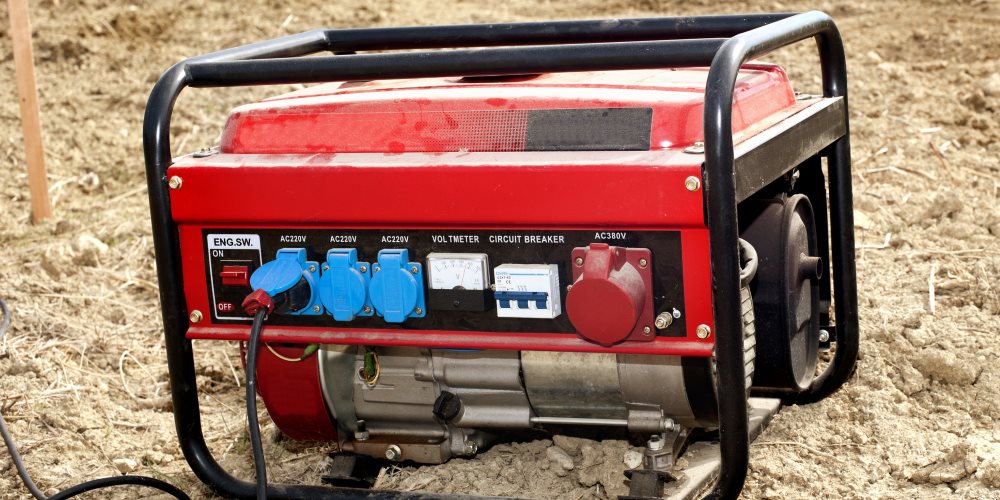
Because we get lots of questions with regards to 5500 watt generators, we have decided to add this FAQ section where you can look for helpful information.
If you have any questions that are not answered here, feel free to contact us or leave your question in the comments section available at the end of this article.
In general, this type of machine will run almost all household appliances, power tools, RV and camping appliances, including:
- Small window AC unit – 1,200 watts
- Fridge with a freezer – 700 watts
- Small well pump (1/2 HP) – 1,000 watts
- Washing machine – 1,150 watts
- Coffee maker – 1,000 watts
- Microwave oven – 1,000 watts
- Dishwasher – 1,500 watts
- Pressure cooker – 700 watts
- Espresso machine – 1,300 watts
- Toaster – 850 watts
- Ceiling fan – 60 watts
- Vacuum cleaner – 200 watts
- TV – 85 watts
- Sump pump (1/2 HP) – 1,050 watts
- Small heating system – 500 watts
- Laptop – 50 watts
- VCR / DVD Player – 100 watts
- Smaller electric appliances – 400 watts
- A couple of power tools – 800 watts
- Medium radiant heater – 1,800 watts
- Window AC (10,000 BTU) – 1,200 watts
- Electric water heater – 4,000 watts
- Bench grinder – 1,400 watts
- Radial arm saw – 2,000 watts
- Hammer drill – 1,000 watts
To learn, whether you can run all these at the same time you need to know the power consumption of each appliance in your home.
There are some universal rules and precautions you need to follow when you want to run your generator safely.
The best document on this topic is the OSHA Fact Sheet: Using Portable Generators Safely and here is a quick summary:
- Never attach a generator directly to the electrical system of a structure (home, office, trailer, etc.) unless a qualified electrician has properly installed the generator with a transfer switch.
- Always plug electrical appliances directly into the generator using the manufacturer’s supplied cords or extension cords that are grounded (3-pronged). Inspect the cords to make sure they are fully intact and not damaged, cut or abraded.
- Use ground fault circuit interrupters (GFCIs), especially where electrical equipment is used in or around wet or damp locations. GFCIs shut off power when an electrical current is detected outside normal paths.
- Never use a generator indoors or in enclosed spaces such as garages, crawl spaces, and basements. NOTE: Open windows and doors may NOT prevent CO from building up when a generator is located in an enclosed space.
- If you or others show symptoms of CO poisoning—dizziness, headaches, nausea, tiredness – get to fresh air immediately and seek medical attention.
- Keep fuel containers away from flame producing and heat generating devices (such as the generator itself, water heaters, cigarettes, lighters, and matches).
For more safety tips and precautions, read this article called “Generators and Heating Safety” from New York State Department of Health or the OSHA Fact Sheet: Using Portable Generators Safely.
In general, a 5500 running watts generator should provide enough power to run a small well pump. Sadly, answering this question is really hard without knowing the exact running and starting watts required by your water pump.
I have found rough estimates for different types of pumps:
- 1/3 Horse Power – It takes 750 running watts and 1500 starting watts.
- 1/2 Horse Power – It takes 1000 running watts and 2100 starting watts.
- 3/4 Horse Power – It takes 1500 running watts and 3000 starting watts.
- 1 Horse Power – It takes 2000 running watts and 4000 starting watts.
- 1 & 1/2 Horse Power – It takes 2500 running watts and 5000 starting watts.
As you can see in the estimates above, the issue is not running watts but starting watts. To get the precise numbers, you will need to find the voltage (120 or 240) and horsepower information on the info-plate of your pump.
Then, all it takes to learn required wattage is to apply this equation:
Watts (W or kW) = Volts (V) x Amps (A)
To learn more about powering a water pump with your generator, I highly recommend you to read this great article from Oakville Pump Service called: So You Need a Generator Because Your Water is Off During Power Outages…
Although theoretically, you could run a very small central AC (that is modern and power efficient) with a 5500 running watts generator, we would rather go for an emergency window AC unit as 5500 generators may have too little starting power.
However, the answer to this question depends on the number of running and starting watts your AC unit requires.
These numbers vary from one unit to another and are based on the cooling ability of individual models and brands. That is why you need to look for this data at the name tag of your central AC:
- LRA (Locked Rotor Amps) – This number represents the current you can expect under starting conditions when you apply full voltage.
- RLA (Rated Load Amps) – This number represents the maximum current a compressor should draw under any operating conditions.
- FLA (Full Load Amps) – This number represents the same as the Rated Load Amps.
Just note that you need to take into consideration the amps for both the compressor and the fan unit. To determine, if your 5500 watts generator can run a central AC, please consult the manufacturer or a professional electrician.
To discover the exact power needs of your AC unit, check out this helpful guide: How Many Watts Do 5,000 – 18,000 BTU Air Conditioners Use?
Keep in mind that a typical central air unit runs on a 208/240 volts and is often permanently mounted and hardwired into the electrical system of your house. That is why to safely run this electric appliance you need to connect your generator through a transfer switch.
You should always connect your generator through a transfer switch if you don’t want to damage your appliances or endanger people who may be working on electric lines in your neighborhood.
Usually, a 5,500 running watts generator should provide enough power to run a small sump pump without any issues. However, answering this question is really hard without knowing the exact running and starting watts required by your pump.
I have found rough estimates for different types of sump pumps:
- 1/3 Horse Power – It takes 800 running watts and 1,300 starting watts.
- 1/2 Horse Power – It takes 1,050 running watts and 2,150 starting watts.
As you can see in the estimates above, the issue is not running watts but starting watts. To get the precise numbers, you will need to find the voltage, amperage, and horsepower information on the info-plate of your pump.
Then, all it takes to learn required wattage is to apply this equation:
Watts (W or kW) = Volts (V) x Amps (A)
Just keep in mind that your sump pump will probably require a 240V outlet on your generator. You can read more on this topic here:
In general, a refrigerator takes around 1200 surge watts at the beginning while the compressor kicks in and then it gradually drops down to around 200 running watts.
As you can see, every generator mentioned in this article could run a mid-sized refrigerator.
If you choose at least a 2000 starting watts inverter generator (Yamaha EF2000iSv2, WEN 56200i, or Generac GP2200i), you can power any modern refrigerator with a freezer easily.
Most fridges require about 800 – 1200 starting watts and 5500 watts is more than enough to power them safely.
Also, if your generator has a high total harmonic distortion, your fridge (especially if you have a modern type) may get damaged (that is why we recommend getting an inverter type of generator).
The size of a generator depends on the type of fridge you want to power:
- While modern appliances have much lower power consumption (around 300 – 400 watts), even while the compressor starts to kick in, the older types of fridges are going to need a bigger power supply (around 300 – 1,200 watts).
- Another aspect that will affect the required size of your generator is whether your fridge also comes with a freezer. In such a case it will require even more power (add 80 – 100 watts to those numbers mentioned above).
Learn more about the power consumption of different types of refrigerators in our guide FAQ: What Size Generator Do I Need to Run a Refrigerator?
In general, a 55000 running watts generator should provide enough power to run an air compressor (1 horse power) without any issues. However, answering this question is really hard without knowing the exact running and starting watts required by your air compressor.
I have found rough estimates for different types of compressors:
- 1/2 Horse Power – It takes 975 running watts and 1600 starting watts.
- 1 Horse Power – It takes 1600 running watts and 4500 starting watts.
As you can see in the estimates above, the issue is not running watts but starting watts. To get precise numbers, you will need to find the voltage, amperage, and horsepower information on the info-plate of your compressor.
Then, all it takes to learn the required wattage is to apply this equation:
Watts (W or kW) = Volts (V) x Amps (A)
Read more in these articles:
Usually, a 5500 watt gasoline generator has a 4-stroke engine. If this is the case, you will need to use either SAE 30 (if you live in a hotter climate) or SAE 10W-30 if you are going to use it in a colder climate.
However, there are many things you need to consider while choosing the oil for your machine:
- Whether you got a 2-stroke or a 4-stroke engine
- Starting and operating temperatures
- Type of fuel your machine runs on
- Certifications and classifications of the oil
- The reputation of the brand and company behind the oil
If you need to learn more information on how to choose the best oil for your generator, then consult our guide that is available right here. We provide you also with a list of the best brands in various categories of oil.
In general, a 5500 watt generator provides approximately 45 amps, in case of 120 volts or 23 amps in case of 240 volts. To learn more, you should check out the owner´s manual to the machine you want to buy.
Actually, identifying how many amps there are in a 5500 running watt generator is a very simple process. All you have to do is to apply the following formula:
Amps (A) = Watts (W or kW) / Volts (V)
You need to divide the wattage by the voltage. If you want to convert 5500 watts to amps you need to divide 5500 by 120 or 240 to get the correct numbers. Here is a great conversion calculator, in case you want to check for yourself and our helpful list of over 100+ products and their power needs.
Here is our handy cheat sheet:
- 500 Watts, 120 V = 4.2 A, 240 V = 2.1 A
- 1000 Watts, 120 V = 8.3 A, 240 V = 4.2 A
- 2000 Watts, 120 V = 16.7 A, 240 V = 8.3 A
- 3000 Watts, 120 V = 25.0 A, 240 V = 12.5 A
- 4000 Watts, 120 V = 33.3 A, 240 V = 16.7 A
- 5000 Watts, 120 V = 41.7 A, 240 V = 20.8 A
- 6000 Watts, 120 V = 50.0 A, 240 V = 25.0 A
- 7000 Watts, 120 V = 58.3 A, 240 V = 29.2 A
- 8000 Watts, 120 V = 66.7 A, 240 V = 33.3 A
- 9000 Watts, 120 V = 75.0 A, 240 V = 37.5 A
- 10000 Watts, 120 V = 83.3 A, 240 V = 41.7 A
- 12000 Watts, 120 V = 100.0 A, 240 V = 50.0 A
- 14000 Watts, 120 V = 116.7 A, 240 V = 58.3 A
- 16000 Watts, 120 V = 133.3 A, 240 V = 66.7 A
This question doesn’t have a universal answer as each generator has unique fuel consumption and capacity of the fuel tank. From our experience an average 5500 watt generator runs for approximately 11 hours on a 50% load.
This number is a median that we got after looking at the run time of over 30 generators that provide 5500 running watts.
Here are some examples:
- Yamaha EF6300ISDE – 5,500 running watts – 13.3 hr on a 25% load (4.5 gal)
- Generac GP5500 – 5,500 running watts – 10 hr on a 50% load (7.2 gal)
- Pulsar PG6580E – 5,500 running watts – 12 hr on a 50% load (5.2 gal)
- Westinghouse WGen5500 – 5,500 running watts – 15 hr on a 50% load (6.6 gal)
- PowerShot SPG5568 – 5,500 running watts – 9 hr on a 50% load (6.1 gal)
- Briggs & Stratton S5750 – 5,750 running watts – 11.5 hr on a 50% load (7.5 gal)
- Honda EU7000iS – 5,500 running watts – 16 hr on a 25% load (5.1 gal)
- Ryobi RY905500 – 5,500 running watts – 9 hr on a 50% load (6.0 gal)
- Powermate CX5500 – 5,500 running watts – 12.5 hr on a 50% load (7.0 gal)
One of the most notable advantages of inverter generators is that they’re perfect for powering small devices, such as computers, televisions, and smartphones.
If you prioritize things like fuel efficiency, quietness, portability, and the ability to safely power sensitive electronics, you really can’t go wrong with an inverter generator.
While some traditional generators can produce upwards of 17,000 watts, inverter generators don’t usually reach figures higher than around 7,000.
PROS OF AN INVERTER GENERATOR:
- Produces power with significantly lower THD
- Lighter and smaller
- More energy efficient than traditional generators
- Much lower fuel consumption
- Parallel capability
- Safe for sensitive electronics like laptops or mobile phones
- Quieter than traditional generators
CONS OF AN INVERTER GENERATOR:
- Significantly more expensive than traditional generators
- Lower power output – limited wattage range
- Costly repairs and servicing
- Limited fuel options
For a comprehensive overview of inverter generators and how they work, read our guide here: What Is an Inverter Generator & How Does It Work? (Pros + Cons Included)
There are several features you can consider while shopping for the best generator for your home. Our team here at Generatorist recommends the following:
- At least 1 alternative fuel source if gasoline is not available
- Electric start with manual recoil backup for convenient use by anyone
- Included maintenance-free electric battery with a trickle charger
- Built-in inverter or automatic voltage regulation
- Automatic idle control for reduced fuel consumption
- Durable frame and steel fuel tank
- Fuel gauge and low-oil shutoff
- Manual fuel-shutoff switch/valve
- Longer run time
- OHV (overhead valve) engine
- Spark arrestor
- Multiple types of outlets with covers
- At least one outlet for higher wattage items (30 amp)
- Folding handles with a wheel kit
To read more about how to pick the best generator for your home, check out our helpful guide linked above.
We recommend you consider the following features:
- Fuel Type – For job contractors, we recommend generators that are running on diesel as this type of fuel is more frequently used in other machines that are usually present on the job site. This way, your fuel management will be much easier.
- Long run time – The worst thing that can happen on a job site is downtime as it leads to profit loss. Every refueling takes your machine out of service for some time. Therefore, it is vital to get a generator that can run for a whole shift without the need to refuel. This way, you can do the refueling with basic maintenance after the work shift is over.
- Large gas tank – Although a large gas tank will diminish the portability of your generator, it will enable you to run it for a longer period without the need to refuel.
- Automatic idle control – The automatic idle control (also known as Eco Throttle or Smart Throttle) can save you a lot of fuel costs and can reduce the noise of your generator. It automatically adapts the rotations of your engine to the actual load. If your generator runs idle, this system can significantly reduce the number of rotations per minute.
To discover more features you should look for in your next generator, read our tips in this article here: Choosing The Best Generator for Contractors
There is no single answer to this question. There are several features of your 5500 watt generator you need to consider while choosing your transfer switch.
We are going to cover this topic soon but in the meantime, feel free to read this comprehensive guide from Electric Generators Direct: How to Pick the Perfect Manual Transfer Switch or this one from GeneratorGrid: Transfer Switch for Your Portable Generator: Buyer’s Guide
Looking at the whole spectrum of generators providing 5500 running watts, we have selected three budget-friendly options:
- Westinghouse WGen5500 (1106+ Reviews)
- Predator 5500/6500 (6+ Reviews)
- PowerMate CX5500
Just keep in mind that you get what you pay for. These are affordable machines but lack some of our preferred features.
Our advice is to choose a machine that is powerful but still quiet. Ideally, go for an inverter such as Yamaha EF6300iSDE (23+ Reviews) or a Honda EU7000iS (74+ Reviews).
Based on our database of 5500 running watts generators, there is not a single machine that would be “RV ready” as none has a 30 amp or 50 amp RV outlet built into the panel.
Luckily, you can get a necessary set of adapters (also called dogbones) to easily connect to any machine on this list through either a 20 or a 30 amp outlet.
So pick a generator that fits your needs the most and don’t forget to get the correct RV adapter.
Finding reliable information on the “noisiness” of generators is a tough job to do. However, based on our findings, we can list the following machines as “quietest”:
- Honda EU7000iS (74+ Reviews)
- Yamaha EF6300iSDE (23+ Reviews)
- Honda EM6500S (10+ Reviews)
- Wanco WI6000
In general, if you want a portable generator that is powerful but also quiet at the same time, then go for an inverter. Sadly, these machines are much more expensive than regular generators.
If you are looking for a 5500 running watts generator that offers the most comfortable electric start, then we can recommend you the following machines:
- Honda EU7000iS (74+ Reviews)
- Yamaha EF6300iSDE (23+ Reviews)
- WEN 7000E (108+ Reviews)
Both Honda and Yamaha are well known brands in the industry. They produce high quality machines that have one big downside, they are very expensive. That is why we have listed the WEN generator as an option for those on a tight budget.
While going over our database of 5500 running watts generators, we have identified only one generator that runs on diesel. It is the DuroStar DS7000Q (12+ Reviews).
It’s a well made generator that offers a remote electric start. Sadly, it’s quite heavy with its 305 pounds (138.34 kg) dry weight. However, if you are looking for diesel powered 5500 option, then DuroStar DS7000Q is a good choice.
We have found only one 5500 generator that runs on propane. It’s PowerMate PM0135500 (4+ Reviews). Sadly, it has been discontinued.
If you still need a propane powered generator, you would need to either increase or decrease the running watts category:
- All Power America APG3560CN (24+ Reviews)
- Sportsman GEN7000LP
- Sportsman GEN7500DF (1414+ Reviews)
If you don’t insist on the propane, then our recommendation would be the Winco HPS6000HE/I. It is a Dual Fuel 5500 generator that runs on both gasoline as well as natural gas.
If you are looking for the best inverter generator that provides 5500 running watts, then go for either the Honda EU7000iS (74+ Reviews) or the Yamaha EF6300iSDE (23+ Reviews). Just keep in mind that inverter generators are on the expensive side.
Getting a generator for a construction site? Then look for these features:
- A lot of starting power
- Covered outlets to avoid getting the dirt into them
- Automatic voltage regulation or an inbuilt inverter for clean power
- Quiet machine if you are working in a noise restricted area
- Portability kit included
- Steel fuel tank
Based on these criteria, we have identified the Westinghouse WGen5500 (402+ Reviews) as the best 5500 generator for a construction site that won’t ruin your budget. It is quite affordable and has a sturdy design.
There are also more premium, quieter, high-quality machines that provide a little bit more starting watts such as Honda EU7000iS (74+ Reviews), but these don’t have covered outlets.
Are you looking for the best 5500 generator that has a plastic gas tank? There are not many options to choose from but the best generator is YAMAHA EF6300ISDE (23+ Reviews).
things to consider
A lot of people rush into getting a backup power unit for their home without realizing that there are some other less-talked-about things associated with using a generator.
Transfer switch
One of the most overlooked facts when getting a backup generator for your home is the need to get and install a transfer switch by a professional electrician. Running a generator without it is not safe and limits your powering abilities.
The transfer switch is a small electrical board (similar to a circuit breaker panel) that will make sure you are not going to damage your generator, fry your electric appliances, or endanger anyone working on power lines.
Also, you can’t safely connect and operate essential electric appliances that are hardwired into your house´s wiring system such as central heating and air conditioning, water and sump pumps, or water heaters.
There are two main types of residential transfer switches for you to choose from:
- Manual – While these units costs between $100.00 – $800.00, you can expect to pay more as it is around 3-4 hours long job for a professional electrician to install it and he or she can charge between $50.00 – $100.00 per hour. That makes it additional $200.00 – $400.00 for labor.
- Automatic – In general, these units are more expensive as their price range is somewhere between $300.00 – $2,000.00, and its installation will be closer to the $300.00 – $400.00 range.
Luckily, there is also a less expensive alternative to the transfer switch called an interlock device. This is a small connector that will enable you to connect your portable generator to the service panel without the need for a transfer switch and it will cost you around $50.00 – $150.00.
Its installation should be done by a professional electrician so there will be some labor costs as well. Just keep in mind that not every electrical system or a building can use interlock device.
It will make some noise
Although it is quite obvious, a lot of people do not realize that a generator can be really noisy, especially if you run it in a densely populated area. Trust me, your neighbors will not be very happy about your generator running unless you are going to share some of your power.
If you don’t have a big piece of land all around your house, it is always a good idea to invest into a quiet machine. The quietest portable generators we know produce around 55 dBA on 50% load. That is as quiet as an urban background noise during the daytime (it is even quieter than a normal conversation which is around 70 dBA).
If you don’t want to risk good relations with your neighbors, just let them know that you are going to start your generator in advance and offer them some of your power as a form of compensation for the noise.
regular maintenance
As every other machine that has engine in it, even your generator will require a regular attention. Luckily, as long as you are a handyman you can manage to do the basic maintenance on your own.
In most cases, you will need to do just the basics:
- Control engine oil levels and change old oil for a new one
- Inspect and replace old spark plugs
- Inspect, clean, and replace air filters
- Give your machine a test run every month
- Keep both your unit and the body of your engine clean
- Inspect and clean fuel filter and gas tank
- Inspect and clean spark arrester
- Inspect and fix any loose bolts, wires, or rusty parts
Although it may sound like a lot, you can do the most within two hours. If you feel like any of the processes above are over the limits of your capabilities, then expect to pay some money at local service station of small engines.
An expert employed there will gladly do the maintenance for you.
Storage requirements
Storing your generator may not be as easy as it may seem in the first place. The most comfortable way to store your unit is to get a wheel kit and a foldable handle to easily move your machine around.
Also, you need to keep in mind that if you are going to store your unit for a longer period of time, you should either drain all the gas from your fuel lines or add a fuel stabilizer into the tank and let it run for a while as otherwise, the gas inside will go bad and will create gum deposits that will clog your carburetor sooner or later.
While draining your fuel, you will find manual fuel-shutoff switch to be a very practical feature. We have created an insightful guide to storing your generator, check it out for more information.
local Laws & regulations
Before you go and buy your generator, it is always the best idea to learn whether there are any local laws and regulations that could limit the spectrum of generators you can choose from. Some states, municipalities, and areas limit the highest allowed noise while others limit the maximum allowed amount of air pollution.
Just ask at local dealer of generators and if they are professionals, they will be able to give you every piece of legislation and regulation that your generator needs to meet if you want to use it in your backyard.
Carbon monoxide
Sadly, even these days there are people dying from carbon monoxide poisoning related to using generators. They don’t realize (or just underestimate) the fact that fumes from their generator are poisonous.
The worst part? Carbon monoxide is an odorless, and colorless gas.
That is why you should never run any generator inside enclosed space or too close to your (or others) home (including open doors and windows) as you could be poisoning yourself or anybody else without even realizing that.
Sadly, the detection of this poisonous gas is almost impossible unless you install a carbon monoxide detector.
Top 5500 Generators
| Most powerful option | Budget Friendly option | Most Exclusive option |
|---|---|---|

|

|

|
| HONDA EU7000iS | Ryobi RY905500 | YAMAHA EF6300iSDE |
| 5500 Running Watts | 5500 Running Watts | 5500 Running Watts |
| 7000 Starting Watts | 6875 Starting Watts | 6300 Starting Watts |
| Runs on Gasoline | Runs on Gasoline | Runs on Gasoline |
| Electric start (recoil backup) | Recoil pull start | Electric start (optional remote) |
| 120/240 AC Voltage | 120/240 AC Voltage | 120/240 AC Voltage |
| No DC Voltage | No DC Voltage | No DC Voltage |
| Runs 18 hours at 25% load | Runs 9 hours at 50% load | Runs 13.3 hours at 25% load |
| 52 dBA at 25% load | 78 dBA at 25% load | 58 - 64 dBA at 25% load |
| 261.5 lb (118.6 kg) weight | 192 lb (87 kg) weight | 200 lb (90.71 kg) weight |
| Check price | Check price | Check price |
About Generatorist

Matthew Gerther
Founder, Generator enthusiast
Our aim here at the Generatorist is to become the No. 1 resource for all things related to generators & your power needs. We have helped over 600,000 visitors with our tips, articles and reviews and we will help you as well.
Our work has been featured in many publications around the world – Yahoo.com, Telegram.com, PaylessPower.com, PopSci.com, TopTenReviews.com, TechRepublic.com, iRV2.com, ThePrepared.com, Renogy.com or ADT Solar. Generators are our passion, and we strive to provide the most reliable & most comprehensive information out there.

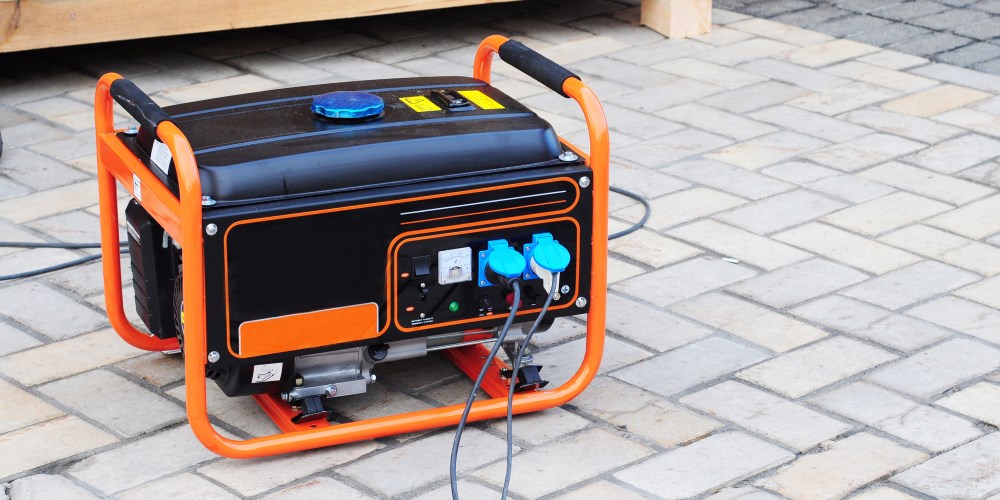

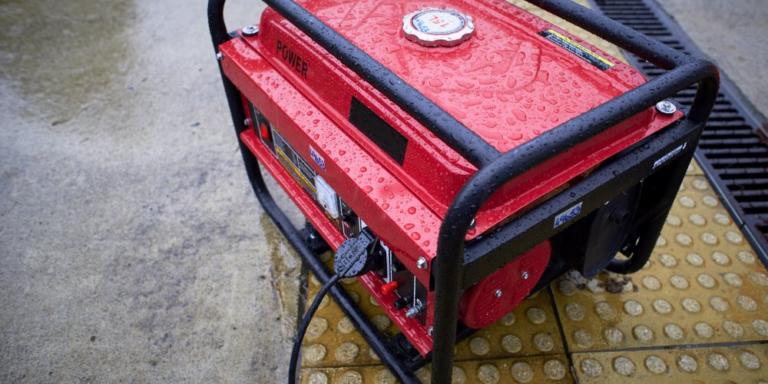

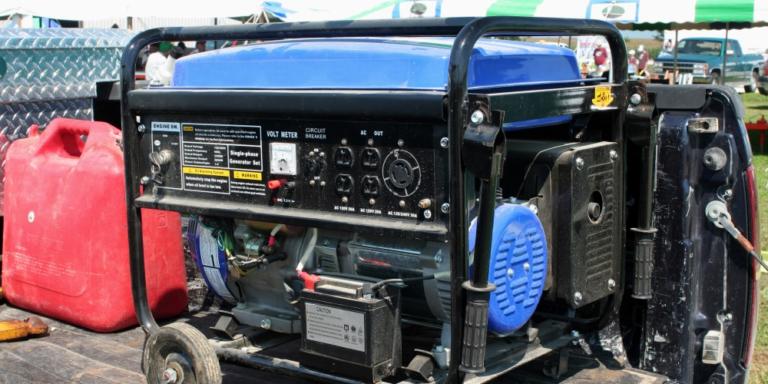
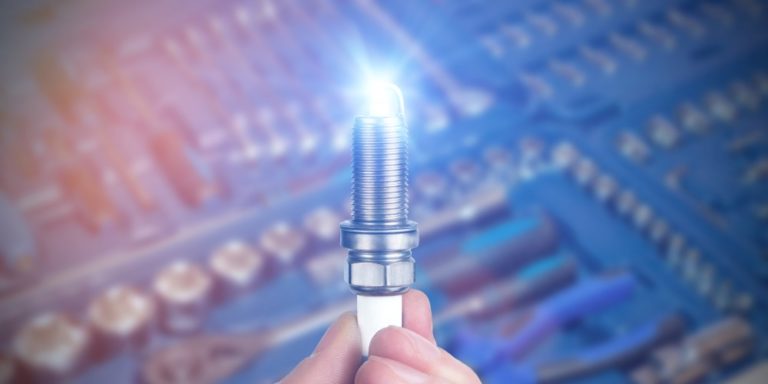


1 thought on “9 Best 5500 Watt Generators: Shopping Guide & Things to Consider”
Honestly, interesting article. Sadly it causes pollution as those gasoline has to turn into something, which in this case is carbon monoxide. Are there environmentally friendly generators in the market?